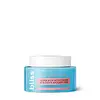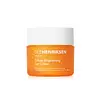What's inside
What's inside
 Key Ingredients
Key Ingredients

 Benefits
Benefits

 Concerns
Concerns

 Ingredients Side-by-side
Ingredients Side-by-side

Water
Skin ConditioningCyclopentasiloxane
EmollientCaprylic/Capric Triglyceride
MaskingGlycerin
HumectantButyrospermum Parkii Butter
Skin ConditioningCetearyl Alcohol
EmollientSqualane
EmollientXylitylglucoside
HumectantHydroxyethyl Acrylate/Sodium Acryloyldimethyl Taurate Copolymer
Emulsion StabilisingMica
Cosmetic ColorantAnhydroxylitol
HumectantCetearyl Glucoside
EmulsifyingCaprylyl Methicone
Skin ConditioningPropanediol
SolventPanthenol
Skin ConditioningTocopherol
AntioxidantTetrahexyldecyl Ascorbate
AntioxidantPyrus Communis Fruit Extract
Skin ConditioningCucumis Sativus Fruit Extract
EmollientLavandula Angustifolia Flower Extract
CleansingRosmarinus Officinalis Leaf Extract
AntimicrobialCamellia Sinensis Leaf Extract
AntimicrobialHelianthus Annuus Seed Oil
EmollientGlycine Soja Oil
EmollientLavandula Angustifolia Oil
MaskingSodium Phytate
Dimethicone/Vinyl Dimethicone Crosspolymer
Skin ConditioningXylitol
HumectantPolysorbate 60
EmulsifyingGlyceryl Stearate
EmollientSorbitan Isostearate
EmulsifyingCetyl Alcohol
EmollientStearyl Alcohol
EmollientCetearyl Olivate
Sorbitan Olivate
EmulsifyingPEG-100 Stearate
Polyglyceryl-4 Laurate/Succinate
Triethoxycaprylylsilane
Isohexadecane
EmollientPhenoxyethanol
PreservativeEthylhexylglycerin
Skin ConditioningCitric Acid
BufferingLinalool
PerfumingCI 77891
Cosmetic ColorantWater, Cyclopentasiloxane, Caprylic/Capric Triglyceride, Glycerin, Butyrospermum Parkii Butter, Cetearyl Alcohol, Squalane, Xylitylglucoside, Hydroxyethyl Acrylate/Sodium Acryloyldimethyl Taurate Copolymer, Mica, Anhydroxylitol, Cetearyl Glucoside, Caprylyl Methicone, Propanediol, Panthenol, Tocopherol, Tetrahexyldecyl Ascorbate, Pyrus Communis Fruit Extract, Cucumis Sativus Fruit Extract, Lavandula Angustifolia Flower Extract, Rosmarinus Officinalis Leaf Extract, Camellia Sinensis Leaf Extract, Helianthus Annuus Seed Oil, Glycine Soja Oil, Lavandula Angustifolia Oil, Sodium Phytate, Dimethicone/Vinyl Dimethicone Crosspolymer, Xylitol, Polysorbate 60, Glyceryl Stearate, Sorbitan Isostearate, Cetyl Alcohol, Stearyl Alcohol, Cetearyl Olivate, Sorbitan Olivate, PEG-100 Stearate, Polyglyceryl-4 Laurate/Succinate, Triethoxycaprylylsilane, Isohexadecane, Phenoxyethanol, Ethylhexylglycerin, Citric Acid, Linalool, CI 77891
Water
Skin ConditioningGlycerin
HumectantDicaprylyl Carbonate
EmollientPropanediol
SolventCaprylic/Capric Triglyceride
Masking3-O-Ethyl Ascorbic Acid
Skin ConditioningGlycereth-26
HumectantAmmonium Acryloyldimethyltaurate/Beheneth-25 Methacrylate Crosspolymer
Emulsion StabilisingHydrolyzed Jojoba Esters
Skin ConditioningCetearyl Alcohol
EmollientPolyacrylate Crosspolymer-6
Emulsion StabilisingHydroxyacetophenone
AntioxidantPanthenol
Skin ConditioningPolyglyceryl-3 Methylglucose Distearate
EmulsifyingTetrahexyldecyl Ascorbate
AntioxidantLinoleic Acid
CleansingCitric Acid
BufferingPhenoxyethanol
PreservativeParfum
MaskingPentaerythrityl Tetra-Di-T-Butyl Hydroxyhydrocinnamate
AntioxidantXanthan Gum
EmulsifyingCetearyl Glucoside
EmulsifyingLinolenic Acid
CleansingCitrus Aurantium Dulcis Fruit Extract
MaskingCitrus Limon Fruit Extract
MaskingHippophae Rhamnoides Extract
MaskingLycium Barbarum Fruit Extract
AstringentRosa Canina Fruit Extract
AstringentEthylhexylglycerin
Skin ConditioningLeuconostoc/Radish Root Ferment Filtrate
AntimicrobialSodium Citrate
BufferingCamellia Japonica Flower Extract
EmollientAroma
Sodium Hyaluronate
HumectantSodium Polyacrylate
AbsorbentSodium Phytate
Hyaluronic Acid
HumectantTriacetin
AntimicrobialHydrolyzed Vegetable Protein
Skin ConditioningAscorbic Acid
AntioxidantTocopherol
AntioxidantLimonene
PerfumingLinalool
PerfumingBenzyl Alcohol
PerfumingCI 15985
Cosmetic ColorantCI 19140
Cosmetic ColorantWater, Glycerin, Dicaprylyl Carbonate, Propanediol, Caprylic/Capric Triglyceride, 3-O-Ethyl Ascorbic Acid, Glycereth-26, Ammonium Acryloyldimethyltaurate/Beheneth-25 Methacrylate Crosspolymer, Hydrolyzed Jojoba Esters, Cetearyl Alcohol, Polyacrylate Crosspolymer-6, Hydroxyacetophenone, Panthenol, Polyglyceryl-3 Methylglucose Distearate, Tetrahexyldecyl Ascorbate, Linoleic Acid, Citric Acid, Phenoxyethanol, Parfum, Pentaerythrityl Tetra-Di-T-Butyl Hydroxyhydrocinnamate, Xanthan Gum, Cetearyl Glucoside, Linolenic Acid, Citrus Aurantium Dulcis Fruit Extract, Citrus Limon Fruit Extract, Hippophae Rhamnoides Extract, Lycium Barbarum Fruit Extract, Rosa Canina Fruit Extract, Ethylhexylglycerin, Leuconostoc/Radish Root Ferment Filtrate, Sodium Citrate, Camellia Japonica Flower Extract, Aroma, Sodium Hyaluronate, Sodium Polyacrylate, Sodium Phytate, Hyaluronic Acid, Triacetin, Hydrolyzed Vegetable Protein, Ascorbic Acid, Tocopherol, Limonene, Linalool, Benzyl Alcohol, CI 15985, CI 19140
Ingredients Explained
These ingredients are found in both products.
Ingredients higher up in an ingredient list are typically present in a larger amount.
This ingredient is an emollient, solvent, and texture enhancer. It is considered a skin-softener by helping the skin prevent moisture loss.
It helps thicken a product's formula and makes it easier to spread by dissolving clumping compounds.
Caprylic Triglyceride is made by combining glycerin with coconut oil, forming a clear liquid.
While there is an assumption Caprylic Triglyceride can clog pores due to it being derived from coconut oil, there is no research supporting this.
Learn more about Caprylic/Capric TriglycerideCetearyl alcohol is a mixture of two fatty alcohols: cetyl alcohol and stearyl alcohol. It is mainly used as an emulsifier. Emulsifiers help prevent the separation of oils and products. Due to its composition, it can also be used to thicken a product or help create foam.
Cetearyl alcohol is an emollient. Emollients help soothe and hydrate the skin by trapping moisture.
Studies show Cetearyl alcohol is non-toxic and non-irritating. The FDA allows products labeled "alcohol-free" to have fatty alcohols.
This ingredient is usually derived from plant oils such as palm, vegetable, or coconut oils. There is debate on whether this ingredient will cause acne.
Due to the fatty acid base, this ingredient may not be Malassezia folliculitis safe.
Learn more about Cetearyl AlcoholCetearyl Glucoside is a surfactant and emulsifier. It can be produced from synthetic of natural sources of cetearyl alcohol and glucose.
Emulsifiers help prevent ingredients from separating, such as oils and waters. It can also be used to enhance the texture of products.
As a surfactant, Cetearyl Glucoside helps during the cleansing process. By gathering all the dirt and oils, it allows these molecules to be washed away easily.
Learn more about Cetearyl GlucosideCitric Acid is an alpha hydroxy acid (AHA) naturally found in citrus fruits like oranges, lemons, and limes.
Like other AHAs, citric acid can exfoliate skin by breaking down the bonds that hold dead skin cells together. This helps reveal smoother and brighter skin underneath.
However, this exfoliating effect only happens at high concentrations (20%) which can be hard to find in cosmetic products.
Due to this, citric acid is usually included in small amounts as a pH adjuster. This helps keep products slightly more acidic and compatible with skin's natural pH.
In skincare formulas, citric acid can:
While it can provide some skin benefits, research shows lactic acid and glycolic acid are generally more effective and less irritating exfoliants.
Most citric acid used in skincare today is made by fermenting sugars (usually from molasses). This synthetic version is identical to the natural citrus form but easier to stabilize and use in formulations.
Read more about some other popular AHA's here:
Learn more about Citric AcidEthylhexylglycerin (we can't pronounce this either) is commonly used as a preservative and skin softener. It is derived from glyceryl.
You might see Ethylhexylglycerin often paired with other preservatives such as phenoxyethanol. Ethylhexylglycerin has been found to increase the effectiveness of these other preservatives.
Glycerin is already naturally found in your skin. It helps moisturize and protect your skin.
A study from 2016 found glycerin to be more effective as a humectant than AHAs and hyaluronic acid.
As a humectant, it helps the skin stay hydrated by pulling moisture to your skin. The low molecular weight of glycerin allows it to pull moisture into the deeper layers of your skin.
Hydrated skin improves your skin barrier; Your skin barrier helps protect against irritants and bacteria.
Glycerin has also been found to have antimicrobial and antiviral properties. Due to these properties, glycerin is often used in wound and burn treatments.
In cosmetics, glycerin is usually derived from plants such as soybean or palm. However, it can also be sourced from animals, such as tallow or animal fat.
This ingredient is organic, colorless, odorless, and non-toxic.
Glycerin is the name for this ingredient in American English. British English uses Glycerol/Glycerine.
Learn more about GlycerinLinalool is a fragrance and helps add scent to products. It's derived from common plants such as cinnamon, mint, citrus, and lavender.
Like Limonene, this ingredient oxidizes when exposed to air. Oxidized linalool can cause allergies and skin sensitivity.
This ingredient has a scent that is floral, spicy tropical, and citrus-like.
Learn more about LinaloolPanthenol is a common ingredient that helps hydrate and soothe the skin. It is found naturally in our skin and hair.
There are two forms of panthenol: D and L.
D-panthenol is also known as dexpanthenol. Most cosmetics use dexpanthenol or a mixture of D and L-panthenol.
Panthenol is famous due to its ability to go deeper into the skin's layers. Using this ingredient has numerous pros (and no cons):
Like hyaluronic acid, panthenol is a humectant. Humectants are able to bind and hold large amounts of water to keep skin hydrated.
This ingredient works well for wound healing. It works by increasing tissue in the wound and helps close open wounds.
Once oxidized, panthenol converts to pantothenic acid. Panthothenic acid is found in all living cells.
This ingredient is also referred to as pro-vitamin B5.
Learn more about PanthenolPhenoxyethanol is a preservative that has germicide, antimicrobial, and aromatic properties. Studies show that phenoxyethanol can prevent microbial growth. By itself, it has a scent that is similar to that of a rose.
It's often used in formulations along with Caprylyl Glycol to preserve the shelf life of products.
Propanediol is an all-star ingredient. It softens, hydrates, and smooths the skin.
It’s often used to:
Propanediol is not likely to cause sensitivity and considered safe to use. It is derived from corn or petroleum with a clear color and no scent.
Learn more about PropanediolSodium Phytate is the synthetic salt form of phytic acid. Phytic acid is an antioxidant and can be found in plant seeds.
Sodium Phytate is a chelating agent. Chelating agents help prevent metals from binding to water. This helps stabilize the ingredients and the product.
Tetrahexyldecyl Ascorbate (THD) is a stable and oil-soluble form of Vitamin C.
THD is special in that it has the ability to travel deeper into skin than traditional ascorbic acid while maintaining the same skin benefits (double win!).
Because it’s oil-soluble, THD dives deep into your skin’s fatty layers (think ceramides and cholesterol) to fight off the kind of free radicals that mess with your skin barrier. This makes it a great pair with water-based vitamin C (ascorbic acid) that mainly works on the surface.
Even at just 0.1%, THD is already showing great antioxidant activity. When used up to 2%, it helps keep your skin happy and calm, especially when it’s stressed from pollution or sun.
Want to fade dark spots or tackle hyperpigmentation? You’ll want 5% or more. Pairing it with brightening buddies like niacinamide or licorice root gives even better results. One study even used 30% THD with other brighteners and saw real results on stubborn discoloration, even in melasma-prone skin.
A note on THD: It’s has a slightly silky, oily texture and usually shows up colorless or pale yellow (though the exact shade can vary by supplier).
While you can sneak it into water-based formulas, it really shines when paired with silicones or oils, which help your skin soak it up better.
THD is pretty stable, but it’s still vulnerable to degradation like ascorbic acid. Too much light or heat (above 113°F / 45°C) can break it down over time. Go for dark and opaque packaging that keeps it safe and shady!
Read more about other types of Vitamin C:
Learn more about Tetrahexyldecyl AscorbateTocopherol (also known as Vitamin E) is a common antioxidant used to help protect the skin from free-radicals and strengthen the skin barrier. It's also fat soluble - this means our skin is great at absorbing it.
Vitamin E also helps keep your natural skin lipids healthy. Your lipid skin barrier naturally consists of lipids, ceramides, and fatty acids. Vitamin E offers extra protection for your skin’s lipid barrier, keeping your skin healthy and nourished.
Another benefit is a bit of UV protection. Vitamin E helps reduce the damage caused by UVB rays. (It should not replace your sunscreen). Combining it with Vitamin C can decrease sunburned cells and hyperpigmentation after UV exposure.
You might have noticed Vitamin E + C often paired together. This is because it is great at stabilizing Vitamin C. Using the two together helps increase the effectiveness of both ingredients.
There are often claims that Vitamin E can reduce/prevent scarring, but these claims haven't been confirmed by scientific research.
Learn more about TocopherolWater. It's the most common cosmetic ingredient of all. You'll usually see it at the top of ingredient lists, meaning that it makes up the largest part of the product.
So why is it so popular? Water most often acts as a solvent - this means that it helps dissolve other ingredients into the formulation.
You'll also recognize water as that liquid we all need to stay alive. If you see this, drink a glass of water. Stay hydrated!
Learn more about Water